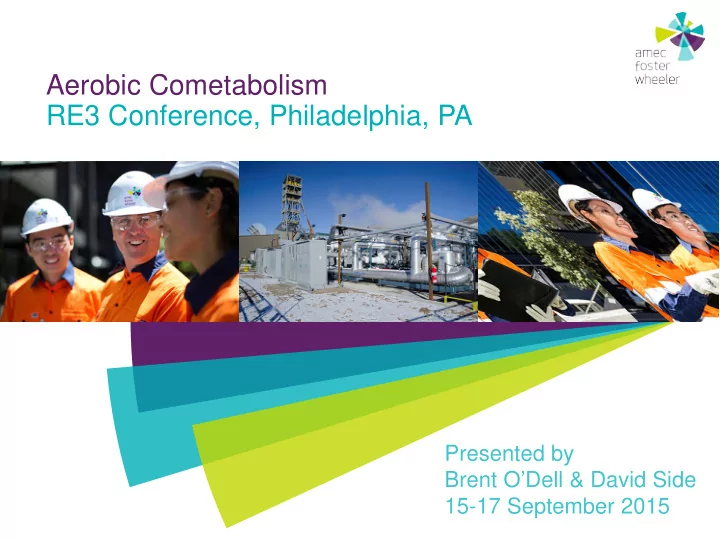

Aerobic Cometabolism RE3 Conference, Philadelphia, PA Presented by Brent O’Dell & David Side 15-17 September 2015
Agenda Introductions Brent O’Dell, PE, Amec E&I Hamilton, NJ – Technical Manager David Side, AMEC E&I Mid-Atlantic, NJ – Senior Geologist Outline Project Overview Lessons Learned Questions and Answers 2
Background Industrial facility in operation for over 80 years Manufacturing of color bases, pigments, and resins Compounds identified in the shallow fractured bedrock : Trichloroethene (TCE) Perchloroethene (PCE) Cis-1,2-dichloroethene (cis-1,2 DCE) 1,2-dichloroethane (1,2-DCA) Chlorobenzene Chloroform Groundwater impacted NJ’s Industrial Site Recovery Act (ISRA) 3
Geology Site location: the Newark Basin in New Jersey Overburden: Approximately 5 to10 feet of anthropogenic fill Residual soil Highly weathered bedrock Underlying the overburden: Mudstone facies of the Passaic Formation Site Strikes at approximately Location N 70 degrees E and dips 10 degrees to the NW 4
Hydrogeology Fractured bedrock beneath the Site: Multi-unit groundwater system Groundwater flows in larger aperture bedding plane fractures Cross cutting joints and other extensional fractures Groundwater systems beneath the Site: Shallow fractured bedrock (up to 80 feet) - Intermediate Unit Deeper fractured bedrock (80 to 130 feet) - Deep Unit Intermediate Unit: yields of approximately 1 gpm or less Deep Unit bedrock zone: yields of 7 to 15 gpm 5
Shallow and Intermediate Contours Aerial View Area of aerobic cometabolism treatment 6
The General Approach Microorganisms naturally occur in the groundwater: Add a hydrocarbon (e.g., propane) Organisms oxidize it for their energy needs Microorganisms produce enzymes that degrade the chloroethenes and chloroethanes Continual / effective delivery of the hydrocarbon = oxygen supporting the enzyme activity 7
Aerobic Cometabolism Diagram 8
Gas Infusion Technology iSOCTM gas infusion technology: Microporous Hollow Fibre A mass transfer technology developed by InVentures Technologies, Inc. Capable of delivering long term, high concentrations of dissolved Cross Section 200 µ m Inner Surface 1 µ m gases ISOC Dissolved gas concentrations in a water column Gas Type Water Column depth (ft) 5' 10' 15' 20' 50' Oxygen 42 55 62 69 111 Methane 22 30 33 37 59 Propane 66 88 99 110 175 Hydrogen 2 2 3 3 5 Ethane 57 75 85 95 150 9
Pilot Test The aerobic cometabolism system: Cylinders of industrial grade oxygen and propane (housed separately in portable garden sheds) Two-stage regulators to control the line pressure in the gas tubing and iSOCTM units SW-5 IW-2 IW-3 SW-20 SW-5 and SW-20 : SW-13 monitoring wells 10
Timeline 2004 2005 2006 2007 2008 2009 2010 2011 2012 2013 2014 2015 System optimization Initiated Continued decreases - maintenance cometabolic of low concentrations pilot test O 2 and nitrogen/ propane mixture alternated in each well Field testing indicated nitrogen/propane infusion suppressed the O 2 infusion 11
Evaluation of Results of SW-13 1000 800 Concentration (ug/L) 600 1,2-Dichloroethane (pre pilot study) 400 1,2-Dichloroethane (post pilot study) 200 0 Jan-93 Oct-95 Jul-98 Apr-01 Jan-04 Oct-06 Jul-09 Apr-12 Dec-14 -200 Date 12
Evaluation of Results of SW-13 140 120 Concentration (ug/L) 100 80 Chlorobenzene (pre pilot study) 60 Chlorobenzene (post pilot study) 40 20 0 Jan-93 Jul-98 Jan-04 Jul-09 Dec-14 -20 Date 13
Evaluation of Results of SW-20 45 40 35 Concentration (ug/L) 30 25 1,2-Dichloroethane 20 (pre pilot study) 1,2-Dichloroethane 15 (post pilot study) 10 5 0 Jan-93 Jul-98 Jan-04 Jul-09 Dec-14 Date 14
Evaluation of Results of SW-20 14 12 Concentration (ug/L) 10 8 6 Chlorobenzene (pre pilot study) 4 Chlorobenzene (post pilot study) 2 0 Jan-93 Jul-98 Jan-04 Jul-09 Dec-14 Date 15
Results DO measurements in SW-5, SW-13, and SW-20 generally indicate enrichment and availability of DO and its distribution away from the infusion wells toward these wells ORP measurements in SW-5, SW-13, and SW-20 have generally been positive and indicative of aerobic enzymatic reactions DAP successfully supplies depleted nutrients HPC measurements indicate a well developed population of microorganisms 16
Conclusions Bioenhancement optimized by: The infusion of pure propane The rotation of propane and oxygen infusion The periodic infusion of propane-only and oxygen-only The addition of DAP Aerobic metabolism/cometabolism and reductive dechlorination processes: Bioenhanced the shallow fractured bedrock groundwater system Reduced COCs, allowed approval of MNA and monitoring Successfully established closure for groundwater 17
Questions Answers 18
Recommend
More recommend